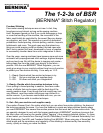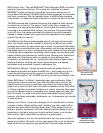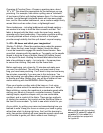
BSR Presser Foot—The new BERNINA
®
Stitch Regulator (BSR) is another
option for free-motion stitching. This unique foot, available for several
BERNINA
®
models, makes you a confident free-motion stitcher even if
you’ve never tried before! The BSR adjusts needle movement to coordinate
with fabric movement. With two sewing modes, the BSR offers regulated,
even stitches, no matter the speed or direction in which the fabric is moved.
The BSR operates with a camera-like sensor that reads the fabric through
an optical lens in the foot. The sensor “looks” at the fabric, senses the
movement, and calculates the distance. It then directs the needle to stitch
according to the selected stitch settings. For example, if the stitch length
is set at 2.5mm, the sensor calculates the distance and stitch frequency
needed to repeat stitches with regular precision regardless of the speed
at which the fabric is moved.
The BSR foot has three interchangeable soles for all types of free-motion
work. The closed metal sole is similar to Darning Foot #9 with the needle
centered and visible; the open metal sole is similar to Freehand Embroidery
Foot #24,with an unobstructed view of the needle; and the large transparent
sole glides easily over fabric, including bulky quilts (where the large diameter
of the clear sole compresses the batting, allowing easy foot movement and
needle visibility) and provides full visibility of the stitching area. Experiment
with each sole, determining which you prefer for each technique and
combination of materials you try – stitching through different types of quilt
batting and fabrics, working with various thread weights, and sewing
techniques such as sashiko, trapunto, bobbinwork, etc.
BSR Machine Settings—Thread the machine with the desired thread in
the needle and bobbin and attach the BSR foot – don’t forget to plug it in!
Lower the feed dog and set the machine for straight stitch. Select the
desired stitch length to “tell” the BSR how long you want your stitches to be.
Select BSR Mode 1 or Mode 2, depending upon your preference. Mode 1
has constant needle movement; even when the fabric stops moving, the
needle continues to move up and down very slowly; this mode gives the
sewer time to stop and think about the path the needle is taking. With Mode
2, stitches are taken only when the fabric is in motion; when the fabric stops
moving the needle comes to a complete stop, starting again only when the
fabric is moved. Try each mode with various techniques (quilting, sashiko,
trapunto, silk-ribbon embroidery, bobbinwork, etc.) to determine your favorite
in each situation.
Marking Your Fabric—Free-motion designs can be stitched with or without
a design to follow. Stipple stitching and “doodling” are often used to fill an
area and are done without following drawn lines. Other designs such as
feathers, wreaths, clamshells, and other traditional quilting designs can be
transferred to the fabric using your favorite method: water- or air-soluble
fabric marker, fabric chalk pencil or marker, or a pounce pad.
Advice for beginners: For your first practice piece you may want to mark a
design on the fabric. Start with a loose, open design that is not too intricate;
there will be time for that once you get the feel of maneuvering the fabric.
Free-motion Feet
#9, #24, and #29
BERNINA Stitch
Regulator Foot with
Interchangeable Soles





